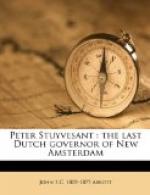The conjuncture was gloomy indeed. Governor Stuyvesant was conscious that he was utterly powerless. He then decided it to be necessary to call to his aid popular representation. A General Assembly of delegates from all the towns was convoked to take into consideration the state of the province. This important meeting was held in the City Hall of New Amsterdam, on the 10th of April, 1664. Twenty-four delegates were present from twelve towns.
Immediately there arose an unfriendly controversy between the governor and the assembly which was fatal to any harmonious or efficient action. The assembly refused to grant the governor the supplies, in money or in men, which he called for, and adjourned for a week. In the meantime Governor Stuyvesant had received dispatches from Holland. The West India Company had acted energetically upon the subject urged in his memorial. They had presented to the States-General a very earnest petition.
In this memorial they laid before that August body, a detailed account of the aggressions committed by the English, and of the repulse with which the Dutch overtures for an amicable settlement had been met at Boston and Hartford.
“Out of respect,” said they,
“to the alliance recently entered into with England, they had hitherto abstained from hostilities. But, as it now seemed absolutely necessary to repel aggression by force, they implored such military and pecuniary aid as the occasion required. They also urged that, in conformity with Governor Stuyvesant’s request, an act should be passed under the great seal, confirming their original charter; and that letters might be sent to the revolted towns on Long Island, requiring them, under the severest penalties, to return to their allegiance. In conclusion they asked that the whole of the aggressions of which they complained might be communicated to the king of England, with the request that he would order his English subjects to restore, on the instant, the places they had seized, and to abstain from all further innovations, pending the negotiations for a boundary line.”
These requests were complied with by the States-General. They sent sixty soldiers to New Amsterdam, with orders to Governor Stuyvesant to resist any further encroachments of the English, and to reduce the revolted villages to allegiance. It was easy for the States-General to issue such an order, but it was not so easy for Governor Stuyvesant to execute it. The Assembly was immediately called together again, and the documents from Holland presented to them. After much deliberation it was decided to be impossible, with the force at the governor’s command, to subdue the English villages. In those villages it was said that the Dutch were outnumbered six to one; and that upon the outbreak of hostilities, the flourishing settlements on the Connecticut would immediately send such a force to Long Island, as would enable them to overcome and take possession of all the other villages.




